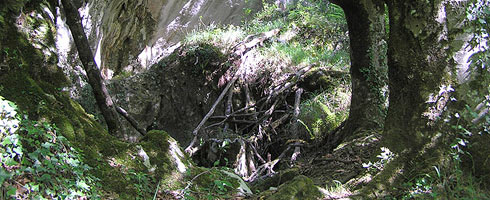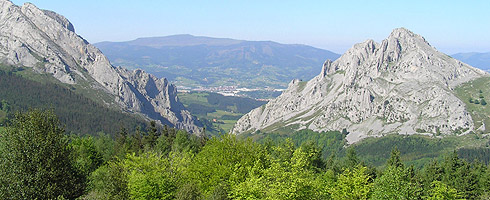Parque Natural de Urkiola · Ayuntamiento de Abadiño
Situación
Menú principal
The first sign of human occupancy in the Urkiola area is in the Asuntze site (Abandiño) where a stratigraphic sequence has been established with signs of the middle Palaeolithic era. However, they have only carried out a demarcation of the archaeological filling of the site, and there is no specific data about its archaeological contents, type of occupancy, etc.
The Upper Palaeolithic era.
The Upper Palaeolithic era is well characterised by the Bolinkoba cave (Abadiño) and in the Silibranka shelter (Mañaria), along with some doubtful data from the Atxuri I and Sailleunta caves, both in Mañaria. The Bolinkoba cave has a stratigraphic with Gravettian (c. 29000-21000 years ago), Solutrense (c. 21000-18000 years ago), Magdalenian (c. 18000-11500 years ago), and Azilian (c. 11500-10000 years ago). The Silibranka shelter is a sequence from Magdalenian to Azilian.

During the Palaeolithic era, cold periods, characteristic of the Würm III and IV glacial cycles, were followed by warmer and damper phases. The Urkiola landscape may have been made up by small and scattered woods that would be in the most protected area. According to the data from the Bolinkoba and Silibranka caves, the strategies to find animal resources were basically based on three hoofed animals: the deer, the goat and the horse. The sea molluscs used for both food and ornaments that have been found in the sites, show that these Palaeolithic hunter-gatherers covered great distances. Likewise the presence the Trebiño flint in Bolinkoba indicates that these Palaeolithic hunters would travel far to the South.

The Epipalaeolithic.
The Epipalaeolithic (c. 10000-6500 years ago), the time of the last hunter-gatherers, is an era which is not represented in Prehistoric Urkiola. The prehistoric era is not represented in any of the sites that have been unearthed, a fact that could be explained by its mere absence within the excavated caves and/or a lack of emphasis on those post-Palaeolithic phases.
The Epipalaeolithic coincides with the start of the Holocene (c. 9800 years ago), when early man began to create settlements in a mild climate rather like today’s. That climatic change led to significant transformations to Urkiola's physical environment: the deciduous forest began to progressively expand and the large fauna began to be replaced by species adapted to the new forest setting, mainly the deer and wild boar. During this phase, there was a rise in the occupation density and a change in the land management strategies. The variety of food resources to be found under the new environmental conditions of the Holocene meant that the settlement process began to stabilise and a economic system emerged. It was based on intensively exploiting a wide range of resources over a smaller area.
The Neolithic and the Ages of Metals.
The data on the first farmers and stockbreeders, from the late Neolithic to the Chalcolithic (c. 5500-3800 years ago) are from the Urkiola domen station. They are extremely limited and there is no precise documentation about the evolution and characteristics of that period. The phenomenon of collective cave burials can be traced back to this cultural cycle, dating back to the Chalcolithic-Bronze Age (c. 45000-2500 years ago), which is well represented in Urkiola. At that time, the population of this region significantly increased, as can be seen from the various burial caves tracing back to that era: the Albiztei and Oyalkoba caves in Abadiño, and Atxuri I and Jentilkoba de Mugarra in Mañaria. Bolinkoba (Abadiño) cave also includes a Bronze Age habitat level in the upper part of its stratigraphy.
In the late Neolithic period (c. 5500 years before the present), there was an abrupt change to the land occupancy model and a general move to living outside. That marked the start of a process that would greatly change the landscape with the introduction of stock-farming and agriculture. The mushrooming of open air settlements (traces of which remain in Urkiola), the construction of megalithic monuments (in the Urkiola station) and the use of cave as collective burial grounds are proof of an intensified use of the territory. This transformation of the landscape, balanced throughout these Prehistoric phases, speed up during History and its outcome was the greatly changed landscape that we know today.
2006 - 2007 © Anteiglesia de Abadiño Town Council - All rights reserved